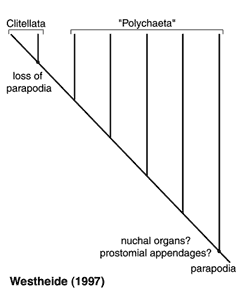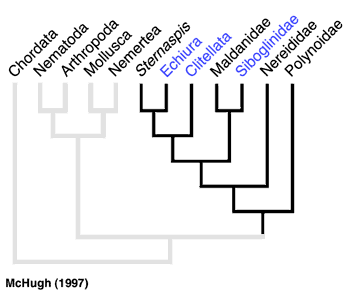Classification
| Domain | Eukarya | |||||||
| Eukaryotes are organisms that have a true nucleolus and membrane-bound organelles. | ||||||||
| Kingdom | Animalia | |||||||
| Organisms under the kingdom Animalia are defined by being multicellular and heterotrophic. They also lack cell walls. These organisms are almost all motile. | ||||||||
| Phylum | Annelida | |||||||
| Annelida comes from Latin meaning "little rings," therefore this is the phylum of ringed worms - this means that the worms in this phylum have bodies broken down in to small compartments or segments. They are coelomates and have a digestive system that runs from the head to anus. | ||||||||
| Class | Oligochaeta | |||||||
| Like the name implies, this class has "few" chaetae or setae. They also lack parapodia and have relatively simple head with no sensory appendages. All of the organisms in this class are hermaphrodic. | ||||||||
| Order | Haplotaxida | |||||||
| This order is mostly comprised of aquatic worms, but Eisenia fetida fits into this order because the defining feature is that the male funnels at least one segment in front of the segment that contains the testes, or male pores. | ||||||||
| Family | Lumbricidae | |||||||
| Within the order of Haplotaxida, the Lumbricidae family is defined by having dorsal setal pairs that are located ventrally, laterally, or dorsolaterally. It also contains organisms with a saddle-shaped clitellum which occupies 4-32 segments (Brinkhurst). The greatest differentiation between the families of Haplotaxida are based on the general area of specific structures such as gizzards, sperm pores, or the clitellum. The location of these structures are generally given in relation to the segments of the worm body. For example, Eisenia fetida has sperm pores in segment 15, a clitellum which is variable from segments 26 or 27 to segments 32 or 33, and a gizzard in segments 17-18. | ||||||||
| Genus | Eisenia | |||||||
| Eisenia is believed to be derived from American zoologist Gustav Eisen's last name. He worked with earthworms in the United States in the seventeenth and eighteenth centuries. One of his published works was Researches in American Oligochaetea which was published in 1900. | ||||||||
| Species | Eisenia fetida (Savigny, 1826) | |||||||
| fetida comes from the Latin word "fetid" which means "foul smelling." This refers to Eisenia fetida's ability to eject a foul smelling liquid from its body if it is roughly handled or fears predation. | ||||||||
Some people think worms are gross, but if that's not you, Eisenia fetida might be too nice for you. Check out some nasty parasitic worms that other students at UW-La Crosse have studied here:
| Echinococcus granulosus | |
| Trichinella spiralis | |
| Anisakis simplex | |
| Taenia saginata | |
Phylogenetic Trees
  |
These two phylogenetic trees above show the classification of taxa in the phylum Annelida. The 1997 Westheide study shows a classification built upon morphological characteristics such as the presence or absence of nuchal organs and parapodia. Eisenia fetida would fall within the general category of Clitellata in both of these diagrams.
The other phylogenetic tree is from another 1997 study; this one by McHugh. These category placements are based upon data from molecular tools. The specific molecular information analyzed was elongation factor 1 alpha in a parsimony analysis. Not only does it show a broader view which includes several other phylum in addition to the Annelids, but it has a somewhat different breakdown of the Annelid phylum (black lines.) Stermaspis is a genus that is wholly composes the family Sternaspidae. This genus is polychaeted and therefore would not be categorized next to the Oligochaetaes in the tree to the left. Also, Echiura are “spoon worms” that, even though they are categorized as Annelids, have no segments. These two taxa demonstrate the additional knowledge that can be received from molecular tools and there importance in classification today.
Another interesting note related to molecular tools comes from Eisenia fetida’s sibling species, Eisenia andrei. This species is considered a molecular species because without molecular tools, it cannot be distinguished from Eisenia fetida. Therefore, its discovery as a separate species has only recently been discovered. The tool used in distinguishing these two obviously closely related species is electrophoresis.